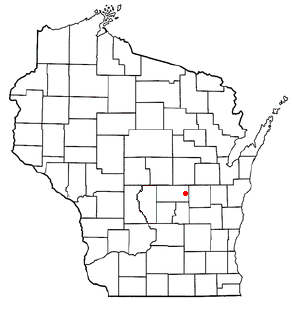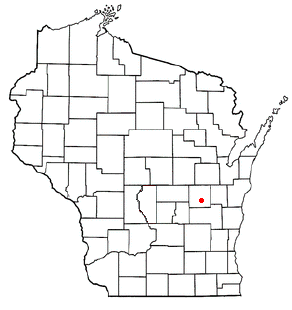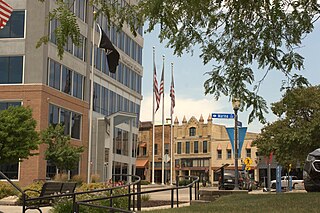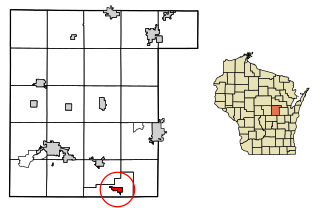
Winnebago County is a county in the U.S. state of Wisconsin. As of the 2020 census, the population was 171,730. Its county seat is Oshkosh. It was named for the historic Winnebago people, a federally recognized Native American tribe now known as the Ho-Chunk Nation. Chief Oshkosh was a Menominee leader in the area. Winnebago County comprises the Oshkosh-Neenah, WI Metropolitan Statistical Area, which is included in the Appleton-Oshkosh-Neenah, WI Combined Statistical Area.

Algoma is a city in Kewaunee County in the U.S. state of Wisconsin. The population was 3,243 at the 2020 census. Algoma is part of the Green Bay Metropolitan Statistical Area.

Meeme is a town in Manitowoc County, Wisconsin, United States. The population was 1,538 at the 2000 census. Its Menominee name is Omīnīw which means "pigeon". The Menominee sold this land to the United States in the 1831 Treaty of Washington.

Hortonville is a village in Outagamie County, Wisconsin, United States. The population was 2,711 at the 2010 census.

Shiocton is a village in Outagamie County, Wisconsin, United States. The population was 921 at the 2010 census. It is wholly surrounded by the Town of Bovina.

Clintonville is a city in Waupaca County, Wisconsin, United States. The population was 4,591 at the 2020 census. The area that became Clintonville was first settled in March, 1855.

Poy Sippi is a town in Waushara County, Wisconsin, United States. The population was 972 at the 2000 census. The census-designated place of Poy Sippi is located in the town. The unincorporated communities of Borth and Fountain Valley are also located in the town.

Algoma is a town in Winnebago County, Wisconsin, United States. The population was 6,822 at the 2010 census. The unincorporated communities of Highland Shore, Leonards Point, Melrose Park, and Oakwood are located in the town.

Black Wolf is a town in Winnebago County, Wisconsin, United States. The population was 2,429 at the 2020 census. The unincorporated communities of Black Wolf, Black Wolf Point, Little Point, Paukotuk, and Point Comfort are located in the town.

Poygan is a town in Winnebago County, Wisconsin, United States. The population was 1,301 at the 2010 census.

Middle Village is a census-designated place (CDP), in the towns of Menominee and Red Springs, in Menominee and Shawano counties in the U.S. state of Wisconsin. It does not have any legal status as an incorporated municipality. The population was 290 at the 2020 census.

New London is a city in Outagamie and Waupaca counties Wisconsin, United States. Founded in 1851, the population was 7,295 at the 2010 census. Of this, 5,685 were in Waupaca County, and 1,640 were in Outagamie County.

Menasha is a city in Calumet and Winnebago counties in the U.S. state of Wisconsin. The population was 18,268 at the 2020 census. Of this, 15,144 were in Winnebago County, and 2,209 were in Calumet County. The city is located mostly in Winnebago County; only a small portion is in Calumet County. Doty Island is located partially in Menasha, which it shares with Neenah. The city's name comes from the Winnebago word meaning "thorn" or "island". In the Menominee language, it is known as Menāēhsaeh, meaning "little island".

Fremont is a village in Waupaca County, Wisconsin, United States. It is surrounded by Town of Fremont. The population was 679 at the 2010 census. Fremont has been referred to as the "White Bass Capital of the World."

Neenah is a city in Winnebago County, Wisconsin, in the north central United States. It is situated on the banks of Lake Winnebago, Little Lake Butte des Morts, and the Fox River, approximately forty miles (64 km) southwest of Green Bay. Neenah's population was 27,319 at the 2020 census.

Oshkosh is a city in and the county seat of Winnebago County, Wisconsin, United States, located on the western shore of Lake Winnebago. It had a population of 66,816 as of the 2020 census, making it the ninth-most populous city in Wisconsin. It is also adjacent to the much less populous Town of Oshkosh in the north. The Oshkosh metropolitan statistical area, which consists of all of Winnebago County, had 171,730 residents in 2020 and is included in the greater Fox Cities region of Wisconsin.
Winneconne is a town in Winnebago County, Wisconsin, United States. The population was 2,350 at the 2010 census. The Village of Winneconne is located within the town, on both sides of the Wolf River. The unincorporated community of Butte des Morts, named for a French and Native American trading war, is also located in the town. The town's water resources of rivers and lakes makes it a center of hunting and fishing, including winter ice fishing.

Oshkosh is a town in Winnebago County, Wisconsin, United States. The population was 2,475 at the 2010 census. It is a northern suburb of the larger City of Oshkosh which it is located adjacent to and partially within. The unincorporated communities of Nichols Shore Acres, Plummer Point, Shangri La Point, and Winnebago are located within the town.

Lake Winnebago is a shallow freshwater lake in the north central United States, located in east central Wisconsin. At 137,700 acres, it is the largest lake entirely within the state, covering an area of about 30 miles by 10 miles with 88 miles of shoreline, an average depth of 15.5 feet, and a maximum depth of 21 feet. It has many shallow reefs along the west shore and a drop-off type shoreline on the east. There are several islands along the west shore.

Lake Poygan, located in the U.S. state of Wisconsin near the village of Winneconne, is an expansive widening of the Wolf River totaling over 14,000 acres (57 km2). Lake Poygan is part of the Winnebago Pool or Wolf Chain, a series of interconnected lakes fed by both the Fox and Wolf rivers. The eastern third of the lake is often referred to as Lake Winneconne. In the Menominee language it is called Pawāhekaneh, "Wild Rice Threshing Lake", referring to the traditional importance of wild rice cultivation to the local economy.


























